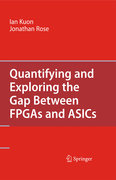
Quantifying and exploring the gap between FPGAs and ASICs
Kuon, Ian
Rose, Jonathan
The book focuses on the cost/area, performance and power consumption differences between Field-Programmable Gate Arrays (FPGAs) and Application Specific Integrated Circuits (ASICs). These differences are referred to as the gap between FPGAs and ASICs and knowledge of this gap is fundamental for people who design FPGAs, who use FPGAs, or who are considering their use. This book reviews and examines the gap in two ways. The first portion of the book focuses on measurements of the silicon area, performance, and power consumption gap. This is done by comparing designs implemented on a commercial FPGA and using an ASIC methodology. Through this comparison, various trends are noted to elucidate some of the design choices that can narrow the gap. The latter half of the book focuses on the trade-offs that can be made in the creation of a FPGA to narrow the gap selectively. This is useful because silicon area, performance and power consumption are not equally important to all users of FPGAs. The book describes the approach used to investigate these trade-offs and it includes a detailed description of the transistor sizing tool developed to assist in this investigation. The scope of the trade-offs is then examined and the effect of thesetrade-offs on the FPGA to ASIC gap is considered. The idea of making cost andperformance trade-offs has been considered in past works but this book explores the use of transistor-sizing to enable these trade-offs. Provides readers with a better appreciation of the gap between FPGAs and ASICs and a deeper understanding of FPGA architecture Corrects common misconceptions about the magnitude of the gap between FPGAs and ASICs and the benefits of FPGA features such as multipliers and memories Conveys the broad range of trade-offs that are possible in the design of FPGAs. In particular, the significant impact of transistor sizing on a FPGA’s efficiency and performance will be highlighted Addresses that lack of information regarding the ASIC or FPGA design choice INDICE: Introduction.- Background.- Measuring the Gap.- Automated Transistor Sizing for FPGAs.- Navigating the Gap Using Architecture and Process Technology Scaling.- Navigating the Gap using Transistor Sizing.- Conclusions and Future Work.
- ISBN: 978-1-4419-0738-7
- Editorial: Springer
- Encuadernacion: Cartoné
- Páginas: 181
- Fecha Publicación: 01/10/2009
- Nº Volúmenes: 1
- Idioma: Inglés
